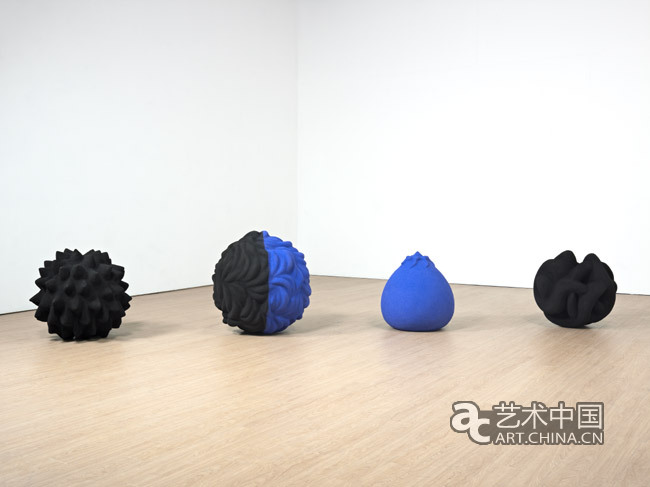安尼施卡普爾-《藍色的聖歌》 |
| 藝術中國 | 時間: 2010-01-29 18:41:27 | 文章來源: 藝術中國 |
|
安尼施卡普爾-《藍色的聖歌》 Anish Kapoor The Chant of Blue 1983 Polystyrene, resin, gesso and pigment in four parts Three pieces 61 x 61 x 61 cm, one piece 76 x 76 x 76 cm 安尼施?卡普爾 藍色的聖歌,1983 聚苯乙烯,樹脂,石膏和不同顏色分為四部分 三件 61 x 61 x 61cm,,一件76 x 76 x 76cm
安尼施?卡普爾的雕塑或用石塊兒砍制,或用拋光的鋼材製成。他能使淺淺的凹坑看起來像無底深淵,孔洞看起來像固體表面。1992年,當他在卡塞爾文獻展(Documenta)展出《墜入地獄》(Descent into Limbo)(1992年)時,觀眾所面對的是一個看起來像圓形地毯的黑色深洞。卡普爾雕塑的力量在於我們對空氣與物質、實在與虛無之間界限的不確定性,陷入了對未知世界極度的恐懼之中。 卡普爾在早期的作品中使用顏料,扭曲了他正在創作的雕塑的輪廓。從深紅色到深藍色,他所使用的或濃重或柔軟的顏色就像吸收了作品周圍的光線。1979年,卡普爾首次在他的雕塑中使用粉狀顏料,明顯參照了他的家鄉印度胡裏節(Holi Festival)上的儀式錶演。最早的作品使用白堊和顏色的勻稱組合。在1983年他製作《藍色的聖歌》(The Chant of Blue)之前,卡普爾把顏料鋪在看起來像奇怪的礦物或植物狀的聚苯乙烯塑膠或玻璃纖維上。它們是另一個世界的東西,像從遙遠的世界帶回的隕星或者樣品,如此的怪異,似乎是極度神秘的象徵。卡普爾曾經説,藝術家不創作物品,他們在製造神話,而且當我們觀賞一個藝術品時,我們看到的是藝術家工作所在的神秘環境。卡普爾所在的時代環境包括偉大的極簡主義(Minimalism)雕刻家唐納德?賈德(Donald Judd)和卡爾?安德烈(Carl Andre),這兩位雕刻家是他1970年代在弘賽藝術學院(Hornsey College of Art)和切爾西藝術學院(Chelsea School of Art)求學時認識的。激勵他並在他的雕塑作品中持久存在的是極簡主義的概念,即:物品有它自己的語言,不會受到創作者歷史或觀眾解釋的限制。結果形成了似乎包含宇宙秘密的一種形式。 傑西卡?萊克 Anish Kapoor Anish Kapoor’s sculptures may be hewn from blocks of stone or made of polished steel, yet he can make shallow depressions look like bottomless pits, and holes look like solid surfaces. In 1992, when he exhibited Descent into Limbo (1992) at Documenta in Kassel, audiences were confronted by a black hole that looked like a circle of carpet. The power of Kapoor’s sculptures lies in our uncertainty as to the boundaries between air and matter, solid and void, tapping into a primal fear of the unknown. Kapoor’s use of pigment in his early sculptures distorts the contours of shapes he is creating. From deep crimson to cobalt blue, his intense and velvety colours appear to suck up the light around them. Kapoor first began using powdered pigment in his sculptures in 1979, a clear reference to the ritual performances of the Holi festival in his native India. By the time he made The Chant of Blue, in 1983, Kapoor was layering the pigment onto polystyrene or fibreglass shapes that looked like strange mineral or plant forms. They were otherworldly, like meteorites or specimens brought back from some distant world, and so alien that they seemed symbolic of a great mystery. Kapoor has said that artists don’t make objects, they make mythologies, and that when we look at a work of art we are seeing the mythological context in which the artist is working. Kapoor’s context includes great Minimalist sculptors such as Donald Judd and Carl Andre, whom he discovered while studying at Hornsey College of Art and Chelsea School of Art in the 1970s. What had excited him, and what endures in his sculptures, is the Minimalist concept that an object has a language of its own, unconstrained by the history of the maker or the viewer’s interpretation. The result is a form that appears to contain the secrets of the universe. Jessica Lack |
| 注:凡註明 “藝術中國” 字樣的視頻、圖片或文字內容均屬於本網站專稿,如需轉載圖片請保留 “藝術中國” 浮水印,轉載文字內容請註明來源藝術中國,否則本網站將依據《資訊網路傳播權保護條例》維護網路智慧財産權。 |
